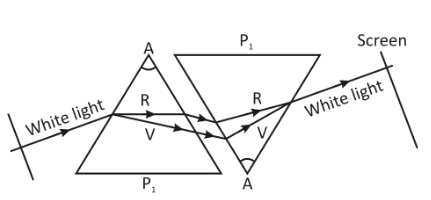
Show that the colours of white light splitted by a glass prism can be recombined to get white light. Describe an activity by another identical glass prism.
Answer
556.5k+ views
Hint:When white light passes through prism it breaks into its constituent colours and if we place another identical prism in an inverted position in the path of the constituent of colours of the light it again recombines to form white light.
Complete answer:
We know from the concept of dispersion of light When a beam of white light incident on a prism it disperses or breaks into all the constituent colours at different angles because the refractive index of light for a given prism varies with the wavelength of the light used. So the emerging beam will be having a coloured band in which all the constituent colours are arranged according to their wavelengths (with red on top and violet at bottom).
If one more prism is arranged in the opposite manner then the dispersed colours will merge into white light beams again. Because again there will be deviation in the opposite direction which will result in the combination of all the constituent colours.
This is shown in the figure below. Here the extreme colours are only shown. All the colours will be arranged as Violet Indigo Blue Green Yellow Orange and Red from down to up. When these passes from the second prism all join together and give a white light as in the figure.

Note: Whenever light encounters a different medium its path deviates from the original path and the deviation of the path depends upon medium as well as the wavelength of the light for same medium deviations can vary depending upon wavelength and in case of prism white light gets splitted into its constituent colours.
Complete answer:
We know from the concept of dispersion of light When a beam of white light incident on a prism it disperses or breaks into all the constituent colours at different angles because the refractive index of light for a given prism varies with the wavelength of the light used. So the emerging beam will be having a coloured band in which all the constituent colours are arranged according to their wavelengths (with red on top and violet at bottom).
If one more prism is arranged in the opposite manner then the dispersed colours will merge into white light beams again. Because again there will be deviation in the opposite direction which will result in the combination of all the constituent colours.
This is shown in the figure below. Here the extreme colours are only shown. All the colours will be arranged as Violet Indigo Blue Green Yellow Orange and Red from down to up. When these passes from the second prism all join together and give a white light as in the figure.

Note: Whenever light encounters a different medium its path deviates from the original path and the deviation of the path depends upon medium as well as the wavelength of the light for same medium deviations can vary depending upon wavelength and in case of prism white light gets splitted into its constituent colours.
Recently Updated Pages
Master Class 12 English: Engaging Questions & Answers for Success

Master Class 12 Business Studies: Engaging Questions & Answers for Success

Master Class 12 Economics: Engaging Questions & Answers for Success

Master Class 12 Social Science: Engaging Questions & Answers for Success

Master Class 12 Maths: Engaging Questions & Answers for Success

Master Class 12 Chemistry: Engaging Questions & Answers for Success

Trending doubts
What are the major means of transport Explain each class 12 social science CBSE

Which are the Top 10 Largest Countries of the World?

Draw a labelled sketch of the human eye class 12 physics CBSE

Explain sex determination in humans with line diag class 12 biology CBSE

The pH of the pancreatic juice is A 64 B 86 C 120 D class 12 biology CBSE

Explain sex determination in humans with the help of class 12 biology CBSE




